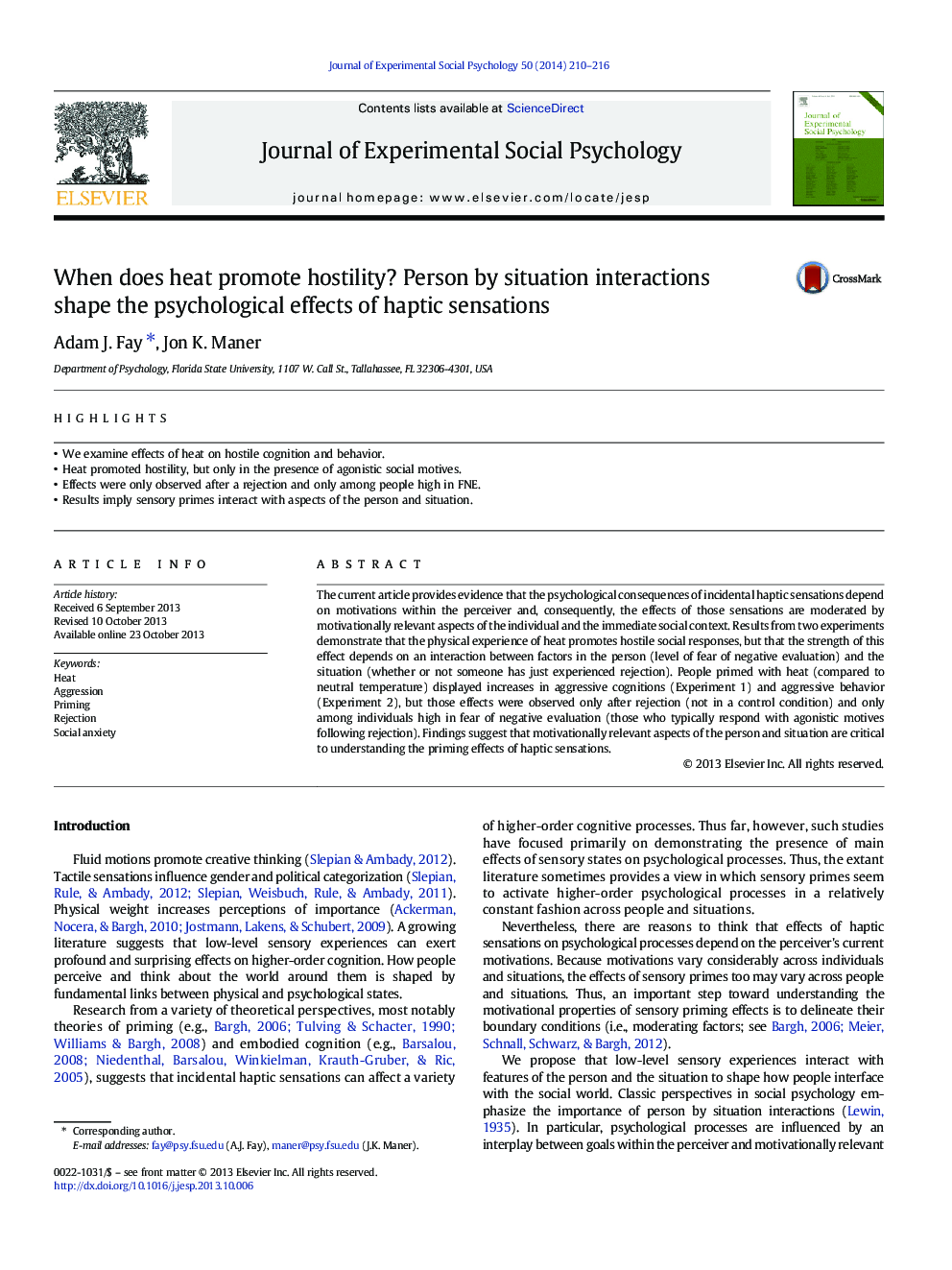| کد مقاله | کد نشریه | سال انتشار | مقاله انگلیسی | نسخه تمام متن |
|---|---|---|---|---|
| 7324947 | 1475873 | 2014 | 7 صفحه PDF | دانلود رایگان |
عنوان انگلیسی مقاله ISI
When does heat promote hostility? Person by situation interactions shape the psychological effects of haptic sensations
ترجمه فارسی عنوان
هنگامی که گرما موجب خصومت می شود؟ فرد با تعاملات وضعیت، تاثیرات روانشناختی احساسات هپتیک را شکل می دهد
دانلود مقاله + سفارش ترجمه
دانلود مقاله ISI انگلیسی
رایگان برای ایرانیان
کلمات کلیدی
حرارت، پرخاشگری آغازگر طرد شدن، اضطراب اجتماعی،
ترجمه چکیده
مقاله حاضر شواهدی را ارائه می دهد که پیامدهای روان شناختی احساسات حسی ناگهانی به انگیزه های درون گیرنده بستگی دارد و در نتیجه تاثیرات این احساس ها با جنبه های انگیزشی مرتبط با فرد و فضای اجتماعی فوری مواجه می شود. نتایج دو آزمایش نشان می دهد که تجربه فیزیکی گرما واکنش های خصمانه اجتماعی را تقویت می کند، اما قدرت این اثر بستگی به تعامل بین عوامل در فرد (سطح ترس از ارزیابی منفی) و وضعیت (اینکه آیا کسی فقط رد تجربه) افرادی که با گرما (در مقایسه با دمای خنثی) شروع به حرارتی کردند، در تجارب تهاجمی (آزمایش 1) و رفتار پرخاشگرانه (تجربی 2) افزایش یافت، اما این اثرات تنها پس از رد (در یک وضعیت کنترل) مشاهده نشد و تنها در میان افرادی که از ترس ارزیابی منفی (کسانی که به طور معمول با انگیزه های پیش پا افتاده پس از رد پاسخ می دهند). یافته ها نشان می دهد که جنبه های انگیزشی مربوط به شخص و وضعیت برای درک اثرات اولیه خواص حسی ضروری است.
موضوعات مرتبط
علوم زیستی و بیوفناوری
علم عصب شناسی
علوم اعصاب رفتاری
چکیده انگلیسی
The current article provides evidence that the psychological consequences of incidental haptic sensations depend on motivations within the perceiver and, consequently, the effects of those sensations are moderated by motivationally relevant aspects of the individual and the immediate social context. Results from two experiments demonstrate that the physical experience of heat promotes hostile social responses, but that the strength of this effect depends on an interaction between factors in the person (level of fear of negative evaluation) and the situation (whether or not someone has just experienced rejection). People primed with heat (compared to neutral temperature) displayed increases in aggressive cognitions (Experiment 1) and aggressive behavior (Experiment 2), but those effects were observed only after rejection (not in a control condition) and only among individuals high in fear of negative evaluation (those who typically respond with agonistic motives following rejection). Findings suggest that motivationally relevant aspects of the person and situation are critical to understanding the priming effects of haptic sensations.
ناشر
Database: Elsevier - ScienceDirect (ساینس دایرکت)
Journal: Journal of Experimental Social Psychology - Volume 50, January 2014, Pages 210-216
Journal: Journal of Experimental Social Psychology - Volume 50, January 2014, Pages 210-216
نویسندگان
Adam J. Fay, Jon K. Maner,
